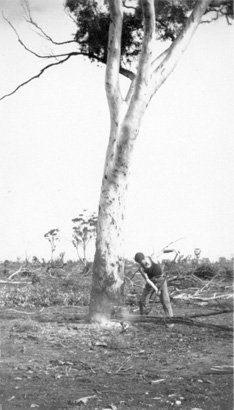|
Land Clearing
When Western Australia became a State in the new Federation on 1 January 1901 it had already enjoyed a decade of rapid expansion in farming. New
agricultural areas, such as Meckering (1889) and Yilgarn (1899) had been opened to settlement by farmers. From 50,000 hectares of land cleared for farming in 1890, that figure increased tenfold to 490,000 hectares by 1900.
The method used for land clearing changed little throughout the twentieth century. For the first two decades horse-drawn scrub rollers were used to
uproot trees and plants.
Blocks ranging in size from 40 to 200 hectares were then cleared using fire.
With the construction of the Goldfields Water Scheme, completed in 1903, water began to be supplied to wheatbelt areas along the route of the pipeline from Northam
to Merredin and beyond. Between 1900 and 1910 the total area of land cleared for farming in Western Australia rose rapidly from 490,000 hectares to 2.1 million hectares.
After 1905 the wheatbelt expanded even further to include areas without permanent streams and surface water. An improved
understanding of the geology of the region and the likely locations of springs, soaks and other underground supplies of water opened more districts of the State for farming. Increased use of rain-water
tanks and dam construction also improved the viability of some regions. Whole new areas were opened for land clearing.
|










